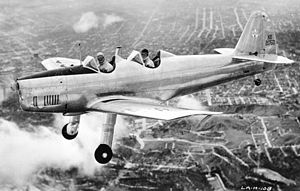North American NA-35
| North American NA-35 | |
|---|---|

| |
| Role | Training aircraft |
| National origin | United States of America |
| Manufacturer | North American Aviation |
| First flight | 1940 |
| Number built | 1 |

The North American NA-35 was a training aircraft designed by North American Aviation. It was first test-flown in January 1940 by Vance Breese. Although announced for trade the month after, the project was pushed aside by plant expansions and the development of the P-51 Mustang. Further test flights were conducted and construction began on a few more aircraft, but the project remained stagnant until Vega Aircraft Corporation bought the rights to the aircraft in October 1940 to develop into the Vega 35.
Specifications
Data from [1]
General characteristics
- Crew: two
- Length: 25 ft 6 in (7.77 m)
- Wingspan: 29 ft 10 in (9.09 m)
- Height: 6 ft 11 in (2.11 m)
- Wing area: 147.2 sq ft (13.68 m2)
- Airfoil: NACA-4416R at root, tapering to NACA-6409R at tip
- Empty weight: 1,218 lb (552 kg)
- Gross weight: 1,760 lb (798 kg)
- Powerplant: 1 × Menasco C4S-2 , 150 hp (110 kW)
Performance
- Maximum speed: 140 mph (230 km/h, 120 kn)
- Cruise speed: 124 mph (200 km/h, 108 kn)
- Range: 305 mi (491 km, 265 nmi)
- Service ceiling: 18,500 ft (5,600 m)
- Rate of climb: 900 ft/min (4.6 m/s)
See also
Aircraft of comparable role, configuration, and era
References
- ^ Juptner, Joseph P. (1993). U.S. Civil Aircraft Series, Volume 8. McGraw-Hill Professional. p. 148. ISBN 978-0-8306-4373-8.
External links
![]() Media related to North American NA-35 at Wikimedia Commons
Media related to North American NA-35 at Wikimedia Commons
